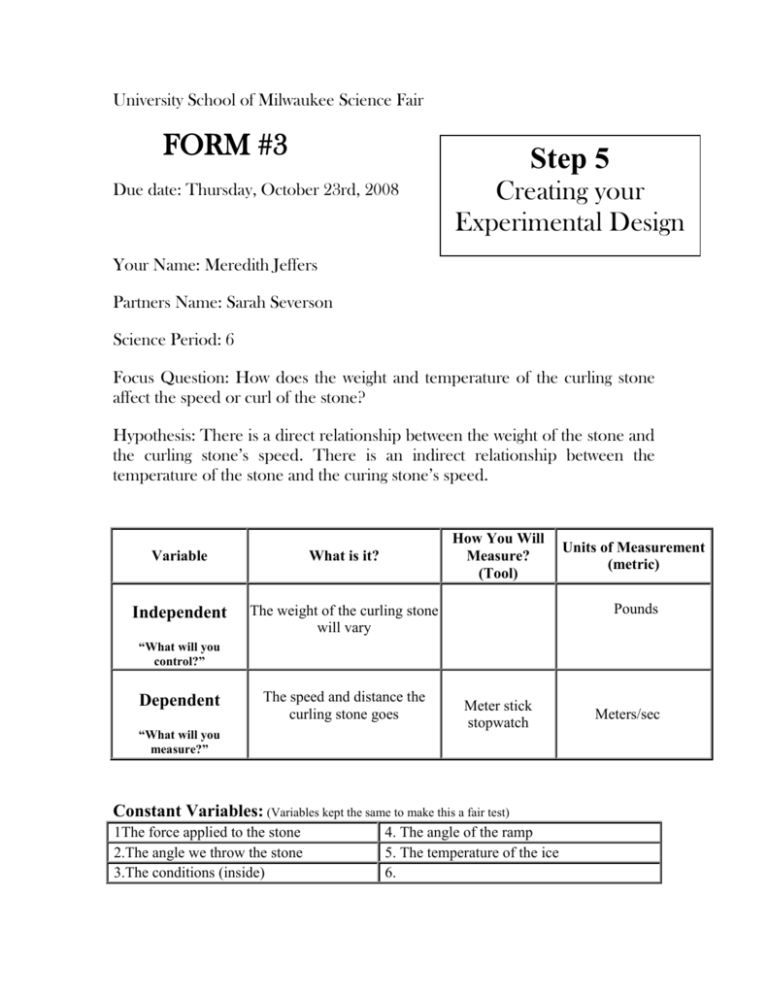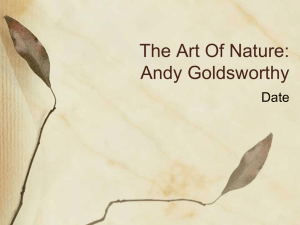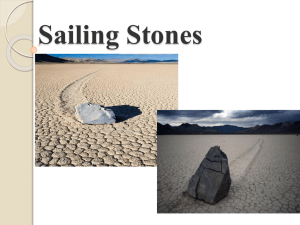Form 3 - science-fair-day
advertisement

University School of Milwaukee Science Fair FORM #3 Step 5 Due date: Thursday, October 23rd, 2008 Creating your Experimental Design Your Name: Meredith Jeffers Partners Name: Sarah Severson Science Period: 6 Focus Question: How does the weight and temperature of the curling stone affect the speed or curl of the stone? Hypothesis: There is a direct relationship between the weight of the stone and the curling stone’s speed. There is an indirect relationship between the temperature of the stone and the curing stone’s speed. How You Will Measure? (Tool) Variable What is it? Independent The weight of the curling stone will vary Units of Measurement (metric) Pounds “What will you control?” Dependent The speed and distance the curling stone goes “What will you measure?” Meter stick stopwatch Constant Variables: (Variables kept the same to make this a fair test) 1The force applied to the stone 2.The angle we throw the stone 3.The conditions (inside) 4. The angle of the ramp 5. The temperature of the ice 6. Meters/sec Step 5 a. Writing a Step by step Procedure 1. 2. 3. 4. 5. 6. 7. 8. Put the ramp on the ice Center the ramp on the target closest to you Hold the 39 pound stone on the top of the ramp As your partner starts the stop watch, release your grip on the stone at the same time Stop the stop watch at the same time to curling stone comes to a halt Measure the distance from the bottom of the ramp to the front of the stone with a meter stick Record your data Repeat steps 1-7 with the weight of the curling stone being 25 and 17 Step 5 b. Developing a Material List -Curling Rink -Smooth Ramp -39 pound granite curling stone -25 pound granite curling stone -17 pound curling stone -Stop watch -Meter Stick Step 5 c. Developing a Data Table Trial 1 Distance (m) Trail Trial Average 2 3 Trial 1 Time (s) Trail Trial Average 2 3 Speed Average Distance Weight of Curling Stone (lb) Temperature of Curling Stone Average Time 39 25 17 Warm Warm Warm 3.96 1.98 2.24 4.06 2.26 1.98 3.81 2.11 2.35 3.94 2.12 2.19 5.16 2.40 2.81 5.68 2.69 2.84 5.43 2.60 3.04 5.42 2.56 2.90 .73 .83 .76 39 25 17 Cold Cold Cold 6.60 2.49 4.32 5.23 2.13 2.86 5.97 2.16 5.23 5.93 2.26 5.93 8.22 3.19 5.41 6.73 2.69 5.13 7.59 3.06 5.12 7.51 2.98 5.22 .79 .76 .78 (m/s) Graphs: Warm Stones Distance 4.5 4 ( 3.5 m 3 e 2.5 t e 2 r 1.5 39 lb 25 lb 17 lb ) s 1 0.5 0 1 2 (Trials) 3 Warm Stones Time 6 ( s e c o n d s 5 4 39 lb 3 25 lb 2 17 lb ) 1 0 1 2 (Trial) 3 Cold Stones Distance 7 ( 6 m e t e r s 5 4 39 lb 3 25 lb 2 ) 17 lb 1 0 1 2 3 (Trials) Cold Stones Time ( s e c o n d s ) 9 8 7 6 5 4 3 2 1 0 39 lb 25 lb 17 lb 1 2 (Trials) 3 Cold Stones Average 8 7 6 5 39 lb 4 25 lb 3 17 lb 2 1 0 (seconds) (meters) 1 Average Distance 2 Average Time 3 Average Speed Warm Stones Average 6 5 4 39 lb 3 25 lb 2 17 lb 1 0 (meters) Average1Distance (seconds) 2 Average Time (m/s) 3 Average Speed Discussion: In every trial the heavier of the three stones, the 39 pound stone, always went the furthest. The colder stones always went further. The average speed of the stones were generally equal. Our results contradict our hypothesis a bit. We had said that as the weight of the stone increases, the speed will increase. According to our data, the cold, heaviest stone went the fastest, but the 17 pound stone went faster than the 25 pound stone. The warm, 25 pound stone went the fastest out of the warm stones, then the 17 pound and then the 39 pound stone. The average speed of the cold stones is faster than the speed of the warm stones by a slight margin. Some sources of error might have been the force in which we dropped the stone down the ramp. Even though we dropped the stone down the ramp without putting any extra force onto the stone, there might have been a difference in the trials. Another error might have been that the ramp was not smooth enough. The speed of the stone might have been diminished when it slid down the plastic ramp. Conclusion: We definitely thought lighter stones would go the farthest because of its weight, but instead the heavier stones went the farthest. We also thought the colder stones would go farther, so we were correct. One thing that really surprised us was that the cold stones average for trial 3 was practically the same. That was especially surprising because the 39 pound stones always went much farther than the other pound stones. It was difficult to measure the distance with a ruler, but we did find out that a broom used in curling was 3 meters long, which helped us a lot. In conclusion this project gave us surprises, accurate responses, and interesting answers. Abstract: Our project concerns the speed of curling stones. We were interested in this project because curling is very close to us. Our project will help our ability to curl and understand the difference of curling stones. In our project we were able to experiment with the temperatures of stones and how that affects the speed. The weight of the stones was another way we could test a curling stone’s speed. Through our project we acquired knowledge about the way curling stones slide across the ice, thus informing us on the stones we should use for curling. We are fortunate enough live close to a curling club. We took a trip down to the Milwaukee Curling Club to run our experiment. We measured the weight of the curling stones were going to use for our project. We used six stones weighing 39, 25, and 17 pounds, three were cold and three were warm. By placing a smooth ramp onto the ice we were able to let the stones slide across the ice with a constant force. We measured the distance the stone slid and the amount of time it took for the stone to stop. This procedure was done three times for the six different stones. We learned that on average colder stones cold travel farther. On average heavier stones travel farther as well. The result of the differing speeds was that the stones all generally slid at the same speed. This surprised us because we were expecting a larger difference in speed between the stones. Although we were expecting different results, this experiment influenced us to be better scientists








